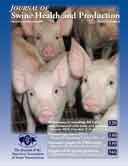Abstract:

Oregano oil as an alternative to antimicrobials in nursery diets
Darryl Ragland, DVM, PhD; Jessica Schneider, RVT; Deborah Stevenson, RVT; Michael A. Hill, BVetMed, MS, PhD, MRCVS; Michael Bakker
PDF version is available online.
Objectives: To evaluate the growth-promoting potential of oregano oil in nursery pigs and evaluate the effect of oregano oil concentration on palatability, feed intake, and growth.
Materials and methods: In Experiment One, 180 seventeen-day-old Yorkshire-Landrace pigs were randomly assigned to three dietary treatments, including an unsupplemented, unmedicated basal diet (Control) and the basal diet supplemented with either 55 g per tonne carbadox (Phibro Animal Health, Ridgefield Park, New Jersey) or 1.5 kg per tonne oregano oil (Van Beek Scientific, Orange City, Iowa). In Experiment Two, 160 twenty-one-day-old Yorkshire-Landrace pigs were randomly assigned to four dietary treatments, including an unsupplemented, unmedicated basal diet (Control) and the basal diet supplemented with 0.5, 1.0, or 1.5 kg per tonne oregano oil. Growth parameters were assessed during a 35-day period in each experiment.
Results: In Experiment One, pigs fed the carbadox-supplemented diet and Control diet exhibited higher average daily gain (ADG) and better feed utilization than pigs fed oregano oil (P < .05). In Experiment Two, pigs fed oregano oil at 1.5 kg per tonne achieved the highest ADG (P < .05). Feed utilization was similar (P > .05) in groups fed oregano oil at 1.0 and 1.5 kg per tonne. Pigs fed the Control diet achieved higher ADG and better feed utilization than pigs fed oregano oil at 0.5 kg per tonne (P < .05).
Implications: Oregano oil supplementation does not support pig growth equivalently to antimicrobial feed additives. Feed intake is not negatively influenced by palatability of oregano oil.
Keywords: nursery, oregano oil, feed additives, growth promotion
![]() Cite as: Ragland D, Schneider J, Stevenson D, et al. Oregano oil as an alternative to antimicrobials in nursery diets. J Swine Health Prod 2007;15(6):346-351.
Cite as: Ragland D, Schneider J, Stevenson D, et al. Oregano oil as an alternative to antimicrobials in nursery diets. J Swine Health Prod 2007;15(6):346-351.
Search the AASV web site for pages with similar keywords.
